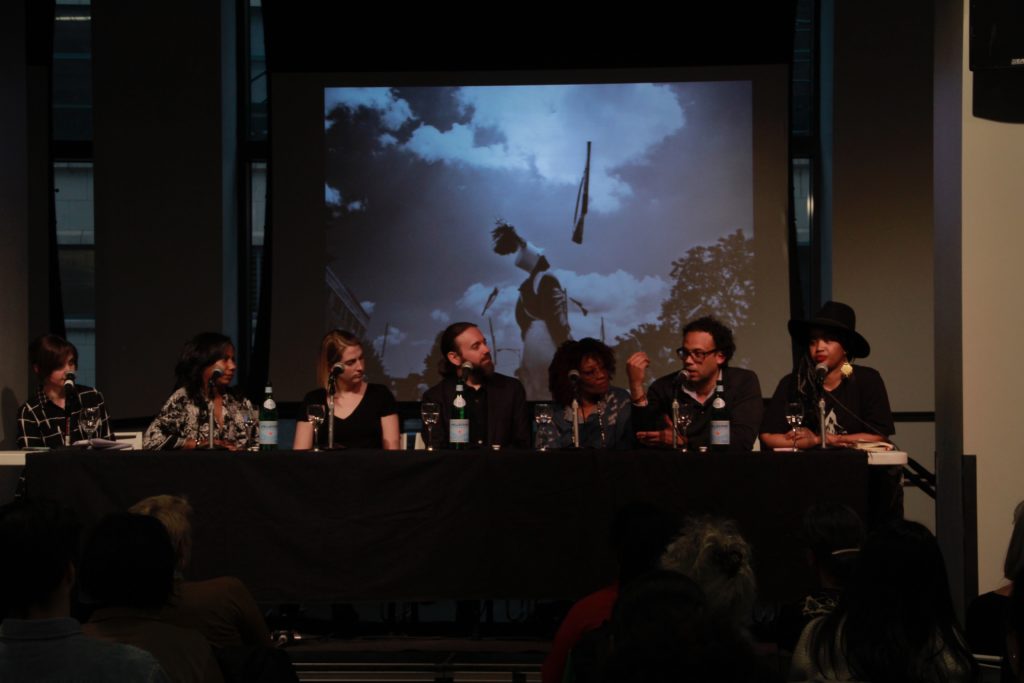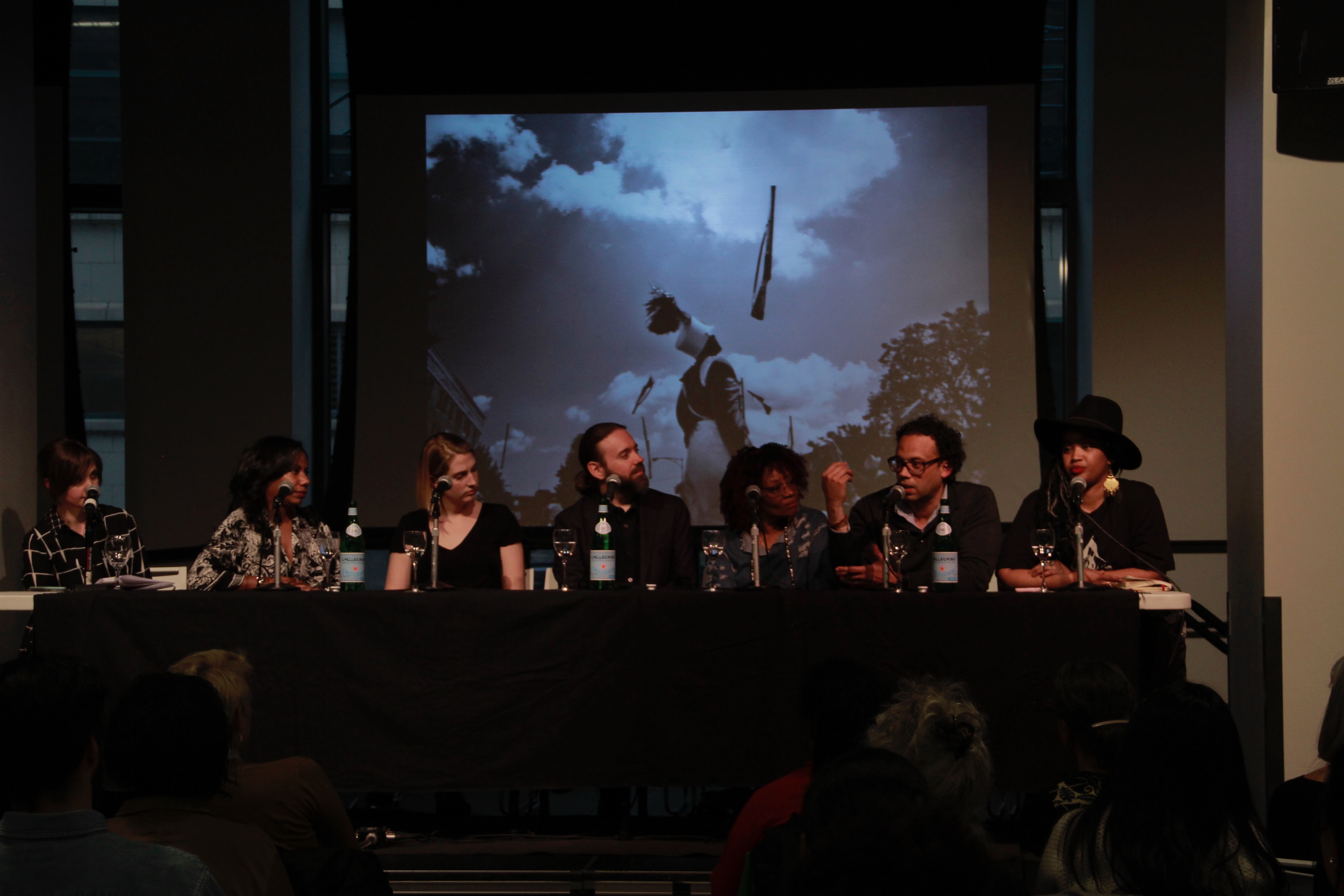Media coverage of violence on the Chicago’s south and west sides is both a symptom and a factor in Chicago’s historic segregation, and one with political and social ramifications felt across the city. In the national media, Chicago is a poster child for “black on black violence,” a one-sided framing of violent crime in disinvested and segregated areas of the country even though the city’s murder rate is far from the highest in the country or even the Midwest.

From left to right: Moderator Kristin Taylor, panelists Natalie Moore, Lucy Baird, David Schalliol, Deborah Payne, Carlos Javier Ortiz and Tonika Johnson.
At a recent panel discussion in Chicago on segregation, Chicago journalist Natalie Moore succinctly summed up the issue like this: “It’s like paint by numbers,” said Moore, a WBEZ public radio reporter and a columnist for the Chicago Sun-Times. “Yellow tape. A neighbor. Somebody crying … You know what the story is.”
For Moore and other journalists in Chicago, it can be a struggle to break through the dominant media narrative about the city’s predominantly black and Hispanic south and west sides, which are often covered in terms of gun violence and crime that occur there. While stories like the ones Moore described may offer a convenient template for news coverage, the proliferation of crime reporting in lieu of deeper analysis of the driving forces behind it can create a stereotypical narrative of some of the city’s most storied and vulnerable neighborhoods. That narrative contributes to the continued segregation of the city itself.
Moore has written and spoken extensively about how this singular media narrative has shaped the way Chicagoans, both in and outside of the affected areas, see their city, how it’s affected the distribution of resources to these neighborhoods and the creation of policies that shape them.
“When unraveling the impact and implications of Chicago violence, we fail to recognize that the media have played a role in contributing to the narrative,” Moore wrote in her 2017 book, “The South Side: A Portrait of Chicago and American Segregation.” “We become what we think we are. Chicagoans are time and time again fed how violent we are, and many people internalize that cognitive belief. The perception of crime is higher than the reality. From the mob to gangs, violence has percolated through the streets of Chicago for the past hundred years. The city has seen it all before; there’s nothing new under the sun. We just don’t remember.”
Although a May 2 panel discussion at the Museum of Contemporary Photography in Chicago aimed to provide a broad overview of segregation in the city, covering the Great Migration to the modern mechanisms of disinvestment in Chicago’s black and brown communities, it only took 30 minutes into the discussion for a panel of activists and journalists (Moore was one of them) to turn its attention to the media’s role.
When violent crimes happen, “this is the only time you see a lot of news organizations come into these neighborhoods,” Moore said. “So it perpetuates stereotypes and it becomes this singular narrative.”
Other panelists included Carlos Javier Ortiz, a cinematographer and photographer; Tonika Johnson, a local artist whose Folded Map project explores Chicago’s racial and economic divide; David Schalliol, a photographer and documentarian; Deborah Payne, an activist in Englewood who is one of the subjects of Schalliol’s recent documentary, “The Area;” and Lucy Baird, a historian focused on housing discrimination. The panel was moderated by Kristin Taylor, at the museum.
Many on the city’s south side share Moore’s concern about how media coverage of their neighborhood can shape the perception of it, even for its residents.
“The same negative narrative that everyone knows about Englewood is shared through the media. That’s also the same narrative that residents in Englewood actually get,” said Johnson, an Englewood native. “Honestly it comes down to the fact that the media is not a place of information for us. There’s an information deficit. So people rely on the news to find out things about their city, about their neighborhood, but when you’re from a neighborhood that’s just reported one way, where do you go? What do you do?”
As well as creating art to highlight the inequity felt on Chicago’s south side, Johnson joined the Resident Association of Greater Englewood, of which Payne is also a member. RAGE was one of the first organizations to host aldermanic forums in the Englewood neighborhood where, before, according to Johnson, incumbent aldermen could expect to keep winning re-election regardless of how their votes affected the parts of the neighborhood they represented. (Aldermen in Chicago represent the city’s 50 wards and serve on the City Council).
RAGE also helped Johnson attain funding to rent billboards in Englewood which were plastered with celebratory photographs taken by Johnson throughout the neighborhood. The billboards, Johnson says, were another way to fight the dominant narrative, to help the residents in Englewood feel proud of where they live.
Moore and Ortiz recalled working for a native Chicagoan editor at Ebony who charged them with writing a slice-of-life story in the Roseland neighborhood in Chicago. The pair spent 48 hours in the neighborhood, from Friday to Sunday. Neither remembered seeing any violence.
The ramifications of racial and economic segregation are too numerous to list. A select few discussed in the panel include the negative impacts on public schools, forced relocations, economic impacts for the greater city (One study by the Metropolitan Planning Council that found segregation is costing Chicago an estimated 4.4 billion a year)in addition to and, of course, the emotional toll it can have on people living in disinvested neighborhoods.
“We see time and time again one of the consequences of segregation is the way that all these kinds of factors get amplified,” Schalliol said. “We know there are real problems that emerge when people are segregated based on class. We know there are real problems when people are segregated based on race. When the two of those things come together, it becomes just absolutely disastrous.”
Panelists also highlighted the good work being done on the south and west sides by many journalists in Chicago. Johnson pointed to the works of newer, hyperlocal outlets like City Bureau and The Triibe, as well as legacy outlets like the Chicago Reporter and WBEZ.
“The good thing about working at WBEZ is that we can choose a little bit more what we do,” Moore said. “You know, there are a lot of news outlets, which is a good thing. But also our audience, if they heard shootings and that kind of round-up coverage, they will call – I mean, they have called – and say ‘that’s not why I’m a member of WBEZ. I can turn on the TV for that.”
Ortiz added, “There’s so many stories out there that you can, if you’re a journalist, you can go cover that nobody’s covering. Just go out and do it and open our eyes to it.”
Work from both Ortiz and Schalliol is on display at the museum in the city’s South Loop through July 7. They offer intimate looks at life on Chicago’s south side.
Ian Karbal is Chicago-based freelance journalist. He can be found on Twitter at @iankarbal.

